The Drift Fence Read online
First Skyhorse Publishing edition 2016 by arrangement with Golden West
Literary Agency
Copyright © 1929 by Zane Grey
Foreword © 2016 by Joseph Wheeler, PhD
All rights reserved. No part of this book may be reproduced in any manner without the express written consent of the publisher, except in the case of brief excerpts in critical reviews or articles. All inquiries should be addressed to Skyhorse Publishing, 307 West 36th Street, 11th Floor, New York, NY 10018.
Skyhorse Publishing books may be purchased in bulk at special discounts for sales promotion, corporate gifts, fund-raising, or educational purposes. Special editions can also be created to specifications. For details, contact the Special Sales Department, Skyhorse Publishing, 307 West 36th Street, 11th Floor, New York, NY 10018 or [email protected].
Skyhorse® and Skyhorse Publishing® are registered trademarks of Skyhorse Publishing, Inc.®, a Delaware corporation.
Visit our website at www.skyhorsepublishing.com.
10 9 8 7 6 5 4 3 2 1
Library of Congress Cataloging-in-Publication Data is available on file.
Cover design by Brian Peterson
Print ISBN: 978-1-63450-814-8
Ebook ISBN: 978-1-63450-076-0
Printed in the United States of America
Contents
Introduction
Chapter 1
Chapter 2
Chapter 3
Chapter 4
Chapter 5
Chapter 6
Chapter 7
Chapter 8
Chapter 9
Chapter 10
Chapter 11
Chapter 12
Chapter 13
Chapter 14
Chapter 15
Chapter 16
Chapter 17
Chapter 18
Chapter 19
Chapter 20
Chapter 21
Chapter 22
Chapter 23
About the Author
INTRODUCTION
THE TENDERFOOT WHO MAKES GOOD AND THE GIRL WHO LONGS FOR MORE
Only a writer who actually lived in the West while it was still “wild” could have written The Drift Fence, thus allowing the word “authentic” to be validly stamped on every page.
It was late summer of 1928, and Grey was fishing from Fisherman, his white-winged yacht, off the island of Tahiti. For some time he’d been thinking about his next book; not easy, for the just-written Arizona Ames was a tough book to follow.
As with all great artistic inspiration, it came to him like a bolt of lightning. During his years of living part-time in his cabin on Arizona’s Mogollon Rim, and interacting with the men, women, and children in this still frontier country, Grey had come to know and empathize with the wild cowboys and the hard-working women who peopled the then Arizona Territory.
Writing about new arrivals to the West was easy because Grey, during his lion-lassoing expedition of 1907-8, had been treated as a tenderfoot himself, when every practical joke cowboys had ever heard of were inflicted on him (this is referenced in Grey’s Last of the Plainsmen). Twenty years later, those practical jokes morphed from real life into fiction: Grey gave the name of Jim Traft to the tenderfoot protagonist who lived through all the torments he’d been forced to endure.
As for the heroine, spunky little Molly Dunn, the lovely sixteen-year-old wood mouse, she too was taken from real life. Grey attended the few public functions held in the Tonto region of Arizona, even the infrequent dances, where liquor, jealousy, courting, and violence were the norm. It was a mighty tough life—especially hard on women, who married young and grew old before their time. Grey’s heart went out to them, and he concluded that he’d model his female protagonist off of them. Additionally, I urge you to pay particular attention to the vernacular when you read this book. Grey did his best to preserve in his novels the actual speech-patterns of his characters.
For anyone today who pigeon-holes Grey’s western novels as little more than shoot-’em-ups, all it would take to disabuse them of this perception would be to read the opening paragraph of this book:
Molly Dunn sat waiting on the rickety old porch of Enoch Summers’ store in the village of West Fork. For once she was oblivious to the approach of the lean-faced, long-legged young backwoodsmen who lounged there with their elders. Molly was sixteen and on the eve of a great adventure. She had been invited to ride to Flagerstown [Flagstaff] with the Sees. She had been there once some years before and the memory had haunted her. In her pocket she had money to buy new stockings and shoes, which compensated somewhat for the fact that she carefully kept her feet and ankles hidden under the bench. She wore her good dress and bonnet, and though not satisfied with them she was not ashamed.
Even today, who could imagine a writer who’d dare to begin a western novel with such a picture of abject poverty—and with a girl at that! But Grey knew his audience, for the greatest family magazines in history serialized his novels—magazines that included American, Good Housekeeping, Ladies’ Home Journal, McClure’s, Cosmopolitan, McCall’s, Pictorial Review, and (ironically), Country Gentlemen.
In Grey’s day, rural Arizona was still locked in isolation, as was true of much of the Southwest. It was a world so inaccessible that it would be an event of the foremost magnitude for a sixteen-year-old girl to ride in a horse-drawn buckboard eighty miles (a two-day’s journey) to shop in the nearest town large enough to stock merchandise. In comparison to today, there was also no mass media—hence an almost double-isolation.
Creations like Molly Dunn are the real reason that there were—and remain today—at least as many female readers of Grey’s novels as there are male readers. It was the genius of Grey that, just by observing and asking questions, he was able to delve so deeply into the hearts and aspirations of the mountain girls all too rapidly forced into adulthood.
Molly is arguably one of Grey’s greatest creations. The pivotal journey of the book her eighty-mile horse-and-buggy ride from the Tonto to then wide-open Flagstaff, where almost all men carry guns. When Molly reaches Flagstaff, a new and fascinating world opens up to her; by the time she returns home, she can never again be fully satisfied with the primitive life she grew up in. Now she longs for more. And it is here in Flagstaff that Molly and Traft first set eyes on each other.
Grey wrote by pencil from 5 to 7 a.m. each morning, before going out to fish. But in his mind, he was back in his beloved Arizona. Thanks to his diaries (which he faithfully kept up), he could travel back in time to the settings in which he would, over time, place a host of characters good and bad, in so many books that would later be treasured by so many millions of readers. Once begun, Grey couldn’t stay away from his story—thus he completed it in only fifty-seven days.
It is safe to say that in no other book Grey ever wrote did he create as full a picture of the American cowboy as he did in The Drift Fence. Few people today are aware that the West of legend was so brief. It began in 1865, with the end of the Civil War and the beginning of the great trail-drives where herds of longhorns were rounded up in South Texas and driven north to railroad yards; it ended with the two worst winters in American history (1887-88 and 1888-89). Those winters brought ruin to thousands of ranchers across the West. As if that wasn’t bad enough, at the same time, barbed-wire changed everything—the free range cowboys loved so much was rudely snatched away, one strand of wire at a time. No wonder cowboys teared up when they sang that mournful lament, “Don’t Fence Me In.”
Grey set his story in 1889, and not coincidentally a centerpiece of the book is the hundred-mile-long barbed-wire drift fence Jim Traft is ordered to build, in the process dramatically changing the western way of life in the region.
Drift Fenc
e is a seminal Western classic in that it quite possibly provides Grey’s most complete depiction of the Western cowboy: what makes him tick; his sense of humor; and his attitude towards the tenderfoot, work, money, loyalty, horses, and women. In recent years, there has been increasing interest in the so-called Code of the West; here is what Grey had to say about it:
First of all, I’d go to town an’ buy the best cowboy outfit I could get, an’ that means saddle, bridle, spurs, chaps, sombrero, gun, boots, ‘and so on. That would be for special occasions. Then I’d wear most of the time just plain overalls. I’d pack a gun an’ begin to learn how to shoot it. I’d have a little straight talk with the boys [most cowboys were young] who was to work under me an’ I’d let them know I was the boss. I’d always do my share of any an’ all kinds of work. I’d show a disposition not to give any boy a job I wouldn’t try to tackle myself. I wouldn’t be too nice to take a drink, on occasions where it might be wise, but I’d leave drink alone. Also … I’d leave the town slatterns alone. I’d lend my money free, but never my hoss or saddle or spurs. I’d always stand the brunt of any trouble directed against my outfit. That’ll be hard, for you’ll find every one of your cowboys keen to do the same thing. Last, an’ I reckon most particular an’ hard, I’d stand up under the hell the Westerners will make for a tenderfoot. I’d run the gauntlet. I’d make all the decent fellows like me—an’ most of them are decent—an’ I’d make the others respect me.
You will discover as you read, that the younger Traft does indeed endure the hell his uncle predicted, a hell that never lets up until the last pages of the book. This is what gives the book its unrelenting suspense—well, half of it is: the other half of the suspense comes from Molly’s desperate flight for the survival of her self-respect and dreams of a better life.
As Grey wrote The Drift Fence, he had no way of knowing he was living his last days on the crest of his personal Mount Olympus, or that his prodigal spending habits would soon catch up with him when the torrent of gold spewing out at him would be suddenly reduced to a trickle. Barely twelve months afterwards, the Great Depression would hit, and keep on hitting for the rest of his life. When the book was serialized in the pages of American in April 1929, Grey and his fellow Americans were unknowingly living on a precipice; but by the time Harpers published the book, on January 3, 1933, the worst depression in American history was raging; Dolly Grey would eventually be forced to fiercely battle for the rest of her husband’s life to stave off bankruptcy. Though his books continued to sell, most readers were forced to read Grey’s books in public libraries rather than purchase their own copies. Interest was so great that libraries were forced to double their orders to keep up with the demand. Later, it would be discovered that the continuing sales of Grey’s books during the Great Depression would enable the august house of Harpers to escape going under.
Characters you’ll find difficult to forget (besides the two lead characters), include the astute Jim Traft, Sr., Molly’s semi-outlaw brother Arch (Slinger) Dunn; faithful Andy Stoneham; kind-hearted Mrs. See; the rollicking cowboy, Curley Prentiss; the despicable villain, Hank Jocelyn; the supposedly deaf cook, Jeff Davis; Molly’s embittered mother; Ring Locke, the range boss; and a host of other characters who play cameo parts.
All in all, by the time you read the last page of this book, you will not only have experienced one of your life’s great reads, you will also have gained a new appreciation for turn-of-the-twentieth-century rural Southwest America. The Drift Fence represents one of the few instances in Grey’s canon where he all but guarantees a sequel—and there would be: The Hash Knife Outfit.
—Joseph Wheeler, Ph.D
Conifer, Colorado
February 2016
CHAPTER
1
MOLLY Dunn sat waiting on the rickety old porch of Enoch Summers’ store in the village of West Fork. For once she was oblivious to the approach of the lean-faced, long-legged young backwoodsmen who lounged there with their elders. Molly was sixteen and on the eve of a great adventure. She had been invited to ride to Flagerstown with the Sees. She had been there once some years before and the memory had haunted her. In her pocket she had money to buy new stockings and shoes, which compensated somewhat for the fact that she carefully kept her feet and ankles hidden under the bench. She wore her good dress and bonnet, and though not satisfied with them she was not ashamed.
Andy Stoneham, a tall youth with sallow face and fuzzy beard, edged over closer and closer.
“Reckon you’re orful stuck up this mawnin’,” he drawled.
Molly looked at the bullet holes in the wall of the old store. She had seen them before, and long ago when she was ten she had stuck her finger in them and wondered about the battle that had been fought there once.
“Goin’ up to Flag, huh?”
“Do you think I’d dress up like this for West Fork?” inquired Molly, loftily.
“Wal, you used to, didn’t you? You shore look purty. But I can’t see you’ve any call to get uppish. I’ve seen you in thet rig before, haven’t I?”
“I don’t remember, Andy.”
“Then you’ve got a darn short memory,” replied Andy, bluntly. “Didn’t I take you to the last dance in thet dress?”
“Did you?”
“Wal, I shore did. An’ didn’t I hug you in it?”
“Did you?” queried Molly, flippantly.
“You bet I did.”
“I’ve forgotten. But I’ve heard it said you’re so big an’ awkward you have to hold on to a girl when you dance. Else you’d fall down.”
“Wal, how aboot kissin’ you, too? On the way to the dance an’ drivin’ home?”
“Oh, did you!” retorted Molly, her face hot. Andy’s voice carried rather far. “An’ what did I do?”
“Wal, I figger thet you kissed me back an’ then slapped my face.”
“Andy Stoneham, you’re a liar about that first.”
“Haw! Haw! … Say, Molly, there’s going to be a dance next week.”
“Where at?”
“Hall’s Mill. Come on an’ go.”
“Andy, I don’t like that place,” returned Molly, regretfully. “Besides, I wouldn’t go with you, anyway.”
“Wal, you shore air gettin’ stuck up. An’ why not?”
“Because of what you said—about huggin’ an’ kissin’ me.”
“What of thet? I did an’ you liked it. Aw, you’re funny. Haven’t all the boys done the same?”
“They have not,” declared Molly “Who ever said such a thing?”
“I heerd Sam Wise say it. An’ Bill Smith laughed, though he didn’t say nothin’.”
“So that’s the kind of fellows you are!” exclaimed Molly. “Talk about a girl behind her back? … To kiss an’ tell!”
“Wal, at thet we’re not so gabby as your cowboy admirers from Pleasant Valley. Take thet red-headed cowpuncher. Accordin’ to his talk he’s a tall fellar with gurls. He shore had you crazy aboot him.”
“He did not,” said Molly, hotly.
“Wal, you acted orful queer then. Danced all the time with him. An’ three times walked out under the pines. Aw, I watched you. An’ come Saturday night he was drinkin’ heah, an’ accordin’ to his talk he could have had a lot more than huggin’ an’ kissin’ from you, if he only got you alone.”
“Andy Stoneham!—You let him talk that way aboot me?”
“Wal, why should I care? You’ve shore been mean to me.”
“Why should you, indeed?” replied Molly, coldly, and turned away.
At that juncture a horseman rode up and his advent not only interrupted Molly’s argument with her loquacious admirer, but had a decided quieting effect upon the other occupants of the porch. He was a lean range-rider, neither young nor old, and he fitted the hard country. His horse showed the dust and strain of long travel.
“Howdy, Seth,” said old Enoch Summers, rubbing his bristled chin and stepping out. “’Pears like you been humpin’ it along. Whar you com
e from?”
“Me an’ Arch Dunn just rode over from the Diamond,” replied the other.
Molly’s attention quickened to interest at the mention of her brother. Seth Haverly was his boon companion and they had been up to something.
“Wal, thar’s news stickin’ out all over you,” drawled Summers.
“Reckon so.”
“Git down an’ come in. Mebbe a drink wouldn’t go bad.”
“Nope. I’m goin’ home an’ get a snack of grub.”
One by one the men on the porch joined Summers. The fact that Seth Haverly did not want a drink, as much as his arrival, interested them.
Haverly had a still brown face and intent light eyes.
“Enoch, you know thet drift fence we been hearin’ aboot for the last year?” he asked.
“Reckon I heerd the talk.”
“Wal, it’s more’n talk now.”
“You don’t say?”
“Yep. Me an’ Arch rode along it, for ten miles, I figger. Straight as a bee-line. New three-wire fence, an’ barbed at thet!”
“What you say? Barbed!”
“You bet.”
Silence greeted Seth’s nonchalant affirmative.
“Arch had a hunch aboot this fence goin’ up,” went on Haverly. “An’ in Flag we found it was a fact.”
“Wal, who’s buildin’ it?”
“Traft.”
“Ahuh. He could afford it. Wal, what’s his idee?”
“It ain’t very flatterin’ to West Fork,” drawled Seth, with a grin. “We heerd some things thet’d be hard for you old cattle nesters to swaller, if they’re true. But me an’ Arch only had the word of some idle cowpunchers. We couldn’t get any satisfaction from Traft’s outfit. New foreman. Nephew from Missourie, we heerd. Tenderfoot, but I agree with Arch, who said he was no fool. Anyway, we asked him polite like: ‘Say, mister, what’s the idee of this drift fence?’—An’ he looked me an’ Arch over an’ said, ‘What do you suppose the idee is?’”
“Short an’ sweet!” ejaculated a man standing beside Summers. “Wal, you two-bit free-range cattlemen can put thet in your pipes an’ smoke it.”

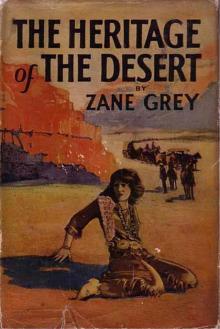 The Heritage of the Desert: A Novel
The Heritage of the Desert: A Novel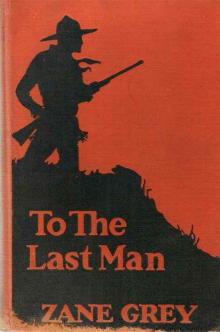 To the Last Man
To the Last Man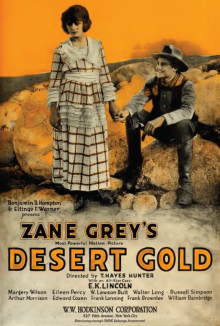 Desert Gold
Desert Gold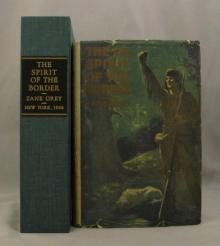 The Spirit of the Border: A Romance of the Early Settlers in the Ohio Valley
The Spirit of the Border: A Romance of the Early Settlers in the Ohio Valley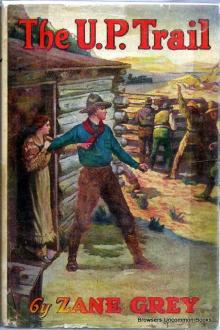 The U. P. Trail
The U. P. Trail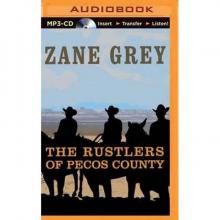 The Rustlers of Pecos County
The Rustlers of Pecos County The Border Legion
The Border Legion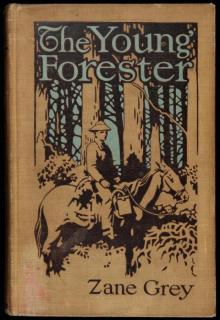 The Young Forester
The Young Forester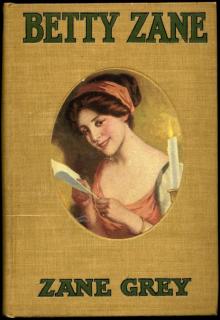 Betty Zane
Betty Zane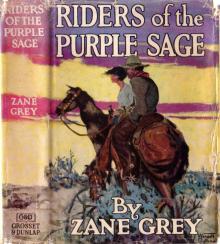 Riders of the Purple Sage
Riders of the Purple Sage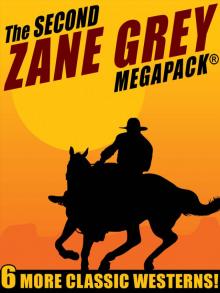 The Second Zane Grey MEGAPACK®
The Second Zane Grey MEGAPACK® The Rainbow Trail
The Rainbow Trail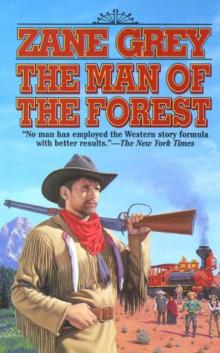 The Man of the Forest
The Man of the Forest The Mysterious Rider
The Mysterious Rider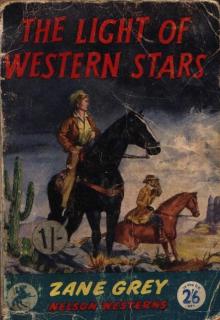 The Light of the Western Stars
The Light of the Western Stars The Last of the Plainsmen
The Last of the Plainsmen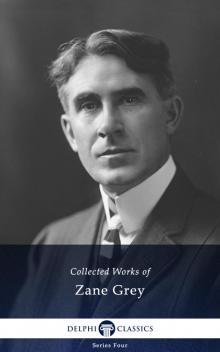 Collected Works of Zane Grey
Collected Works of Zane Grey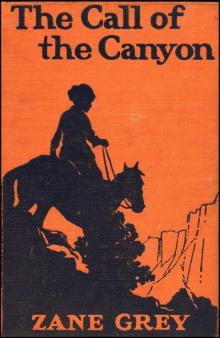 The Call of the Canyon
The Call of the Canyon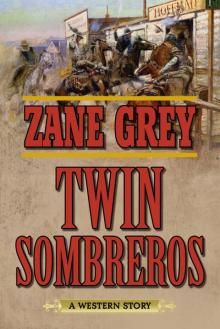 Twin Sombreros
Twin Sombreros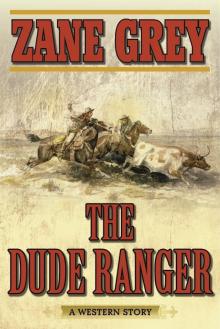 The Dude Ranger
The Dude Ranger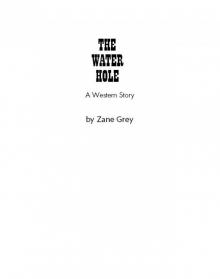 The Water Hole
The Water Hole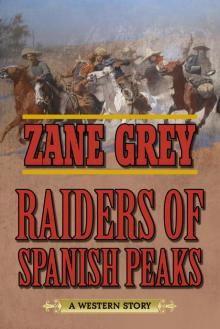 Raiders of Spanish Peaks
Raiders of Spanish Peaks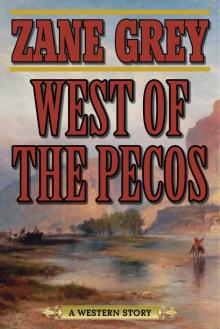 West of the Pecos
West of the Pecos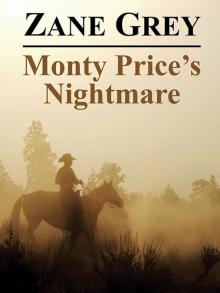 Monty Price's Nightmare
Monty Price's Nightmare Stairs of Sand
Stairs of Sand Rogue River Feud
Rogue River Feud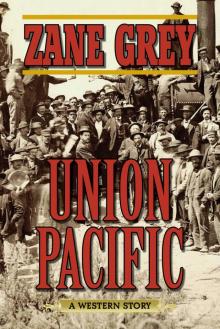 Union Pacific
Union Pacific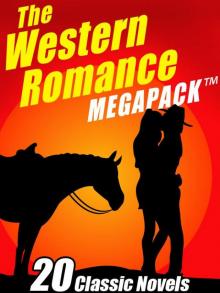 The Western Romance MEGAPACK ®: 20 Classic Tales
The Western Romance MEGAPACK ®: 20 Classic Tales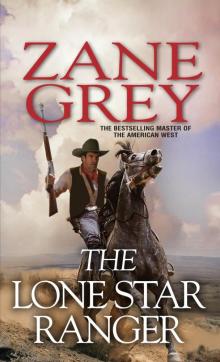 The Lone Star Ranger
The Lone Star Ranger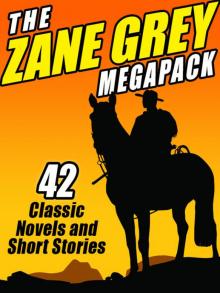 The Zane Grey Megapack
The Zane Grey Megapack Shadow on the Trail
Shadow on the Trail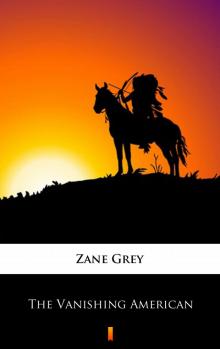 The Vanishing American
The Vanishing American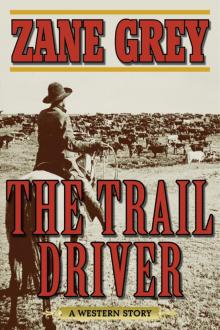 The Trail Driver
The Trail Driver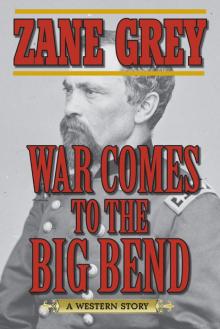 War Comes to the Big Bend
War Comes to the Big Bend The Westerners
The Westerners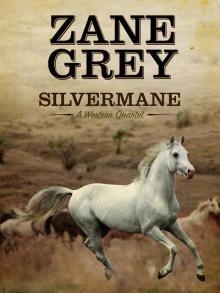 Silvermane
Silvermane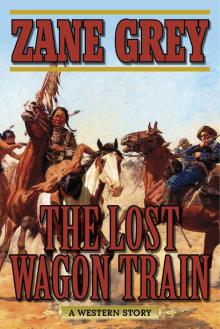 The Lost Wagon Train
The Lost Wagon Train Desert Gold and the Light of Western Stars
Desert Gold and the Light of Western Stars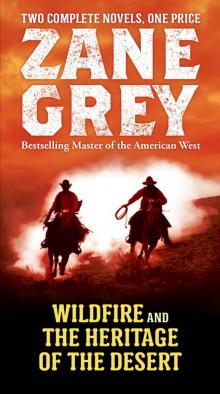 Wildfire and the Heritage of the Desert
Wildfire and the Heritage of the Desert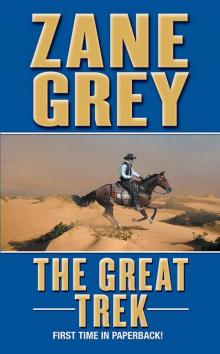 The Great Trek
The Great Trek Cabin Gulch
Cabin Gulch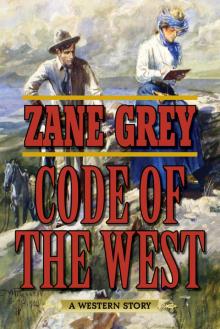 Code of the West
Code of the West Sunset Pass
Sunset Pass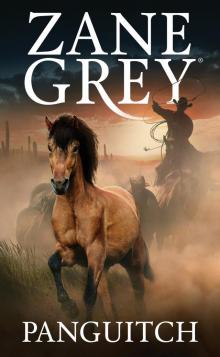 Panguitch
Panguitch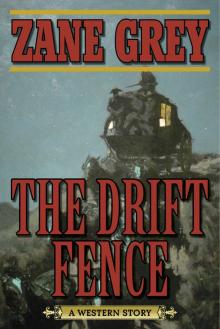 The Drift Fence
The Drift Fence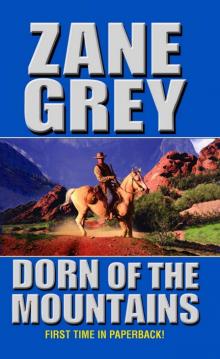 Dorn Of The Mountains
Dorn Of The Mountains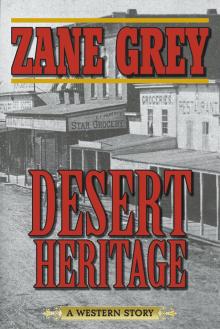 Desert Heritage
Desert Heritage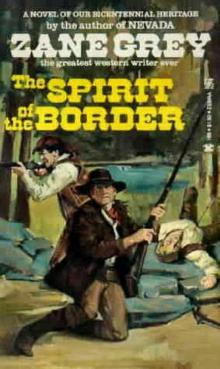 The Spirit Of The Border
The Spirit Of The Border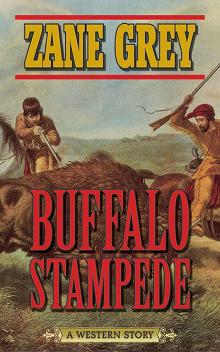 Buffalo Stampede
Buffalo Stampede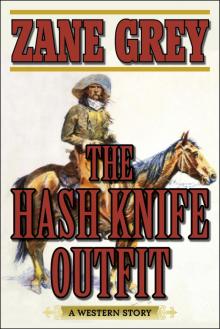 The Hash Knife Outfit
The Hash Knife Outfit The Lone Star Ranger and the Mysterious Rider
The Lone Star Ranger and the Mysterious Rider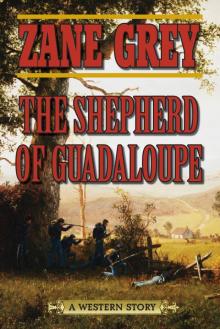 The Shepherd of Guadaloupe
The Shepherd of Guadaloupe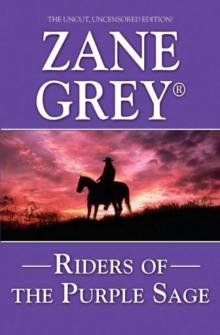 Riders of the Purple Sage (Leisure Historical Fiction)
Riders of the Purple Sage (Leisure Historical Fiction)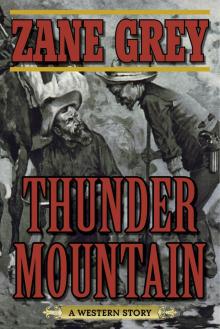 Thunder Mountain
Thunder Mountain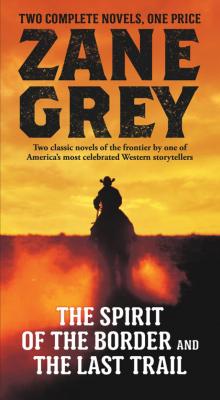 The Spirit of the Border and the Last Trail
The Spirit of the Border and the Last Trail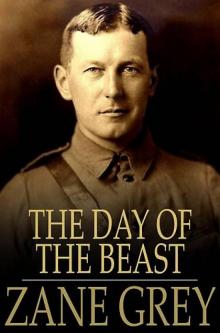 The Day of the Beast
The Day of the Beast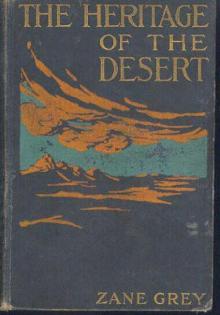 The Heritage of the Desert
The Heritage of the Desert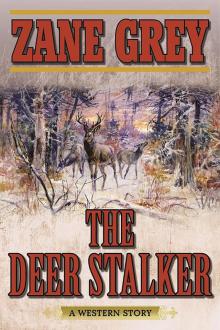 The Deer Stalker
The Deer Stalker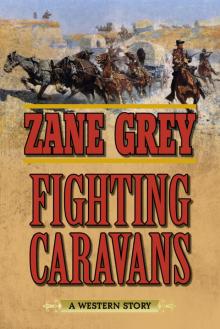 Fighting Caravans
Fighting Caravans